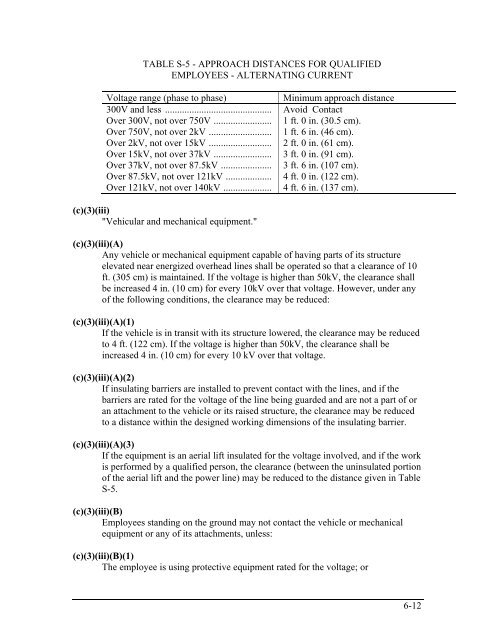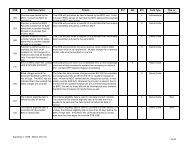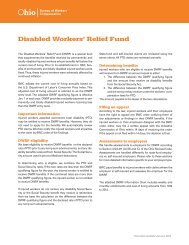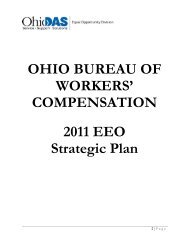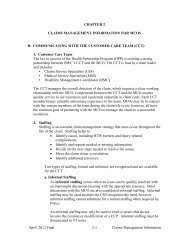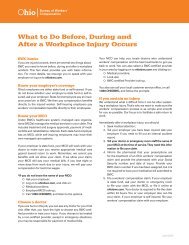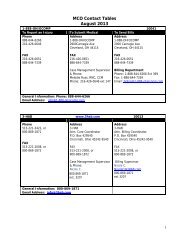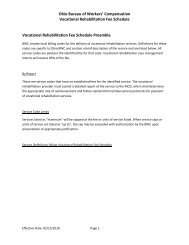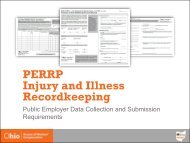Lockout / Tagout - Ohio Bureau of Workers' Compensation
Lockout / Tagout - Ohio Bureau of Workers' Compensation
Lockout / Tagout - Ohio Bureau of Workers' Compensation
You also want an ePaper? Increase the reach of your titles
YUMPU automatically turns print PDFs into web optimized ePapers that Google loves.
TABLE S-5 - APPROACH DISTANCES FOR QUALIFIED<br />
EMPLOYEES - ALTERNATING CURRENT<br />
Voltage range (phase to phase)<br />
300V and less ............................................<br />
Over 300V, not over 750V ........................<br />
Over 750V, not over 2kV ..........................<br />
Over 2kV, not over 15kV ..........................<br />
Over 15kV, not over 37kV ........................<br />
Over 37kV, not over 87.5kV .....................<br />
Over 87.5kV, not over 121kV ...................<br />
Over 121kV, not over 140kV ....................<br />
Minimum approach distance<br />
Avoid Contact<br />
1 ft. 0 in. (30.5 cm).<br />
1 ft. 6 in. (46 cm).<br />
2 ft. 0 in. (61 cm).<br />
3 ft. 0 in. (91 cm).<br />
3 ft. 6 in. (107 cm).<br />
4 ft. 0 in. (122 cm).<br />
4 ft. 6 in. (137 cm).<br />
(c)(3)(iii)<br />
"Vehicular and mechanical equipment."<br />
(c)(3)(iii)(A)<br />
Any vehicle or mechanical equipment capable <strong>of</strong> having parts <strong>of</strong> its structure<br />
elevated near energized overhead lines shall be operated so that a clearance <strong>of</strong> 10<br />
ft. (305 cm) is maintained. If the voltage is higher than 50kV, the clearance shall<br />
be increased 4 in. (10 cm) for every 10kV over that voltage. However, under any<br />
<strong>of</strong> the following conditions, the clearance may be reduced:<br />
(c)(3)(iii)(A)(1)<br />
If the vehicle is in transit with its structure lowered, the clearance may be reduced<br />
to 4 ft. (122 cm). If the voltage is higher than 50kV, the clearance shall be<br />
increased 4 in. (10 cm) for every 10 kV over that voltage.<br />
(c)(3)(iii)(A)(2)<br />
If insulating barriers are installed to prevent contact with the lines, and if the<br />
barriers are rated for the voltage <strong>of</strong> the line being guarded and are not a part <strong>of</strong> or<br />
an attachment to the vehicle or its raised structure, the clearance may be reduced<br />
to a distance within the designed working dimensions <strong>of</strong> the insulating barrier.<br />
(c)(3)(iii)(A)(3)<br />
If the equipment is an aerial lift insulated for the voltage involved, and if the work<br />
is performed by a qualified person, the clearance (between the uninsulated portion<br />
<strong>of</strong> the aerial lift and the power line) may be reduced to the distance given in Table<br />
S-5.<br />
(c)(3)(iii)(B)<br />
Employees standing on the ground may not contact the vehicle or mechanical<br />
equipment or any <strong>of</strong> its attachments, unless:<br />
(c)(3)(iii)(B)(1)<br />
The employee is using protective equipment rated for the voltage; or<br />
6-12


